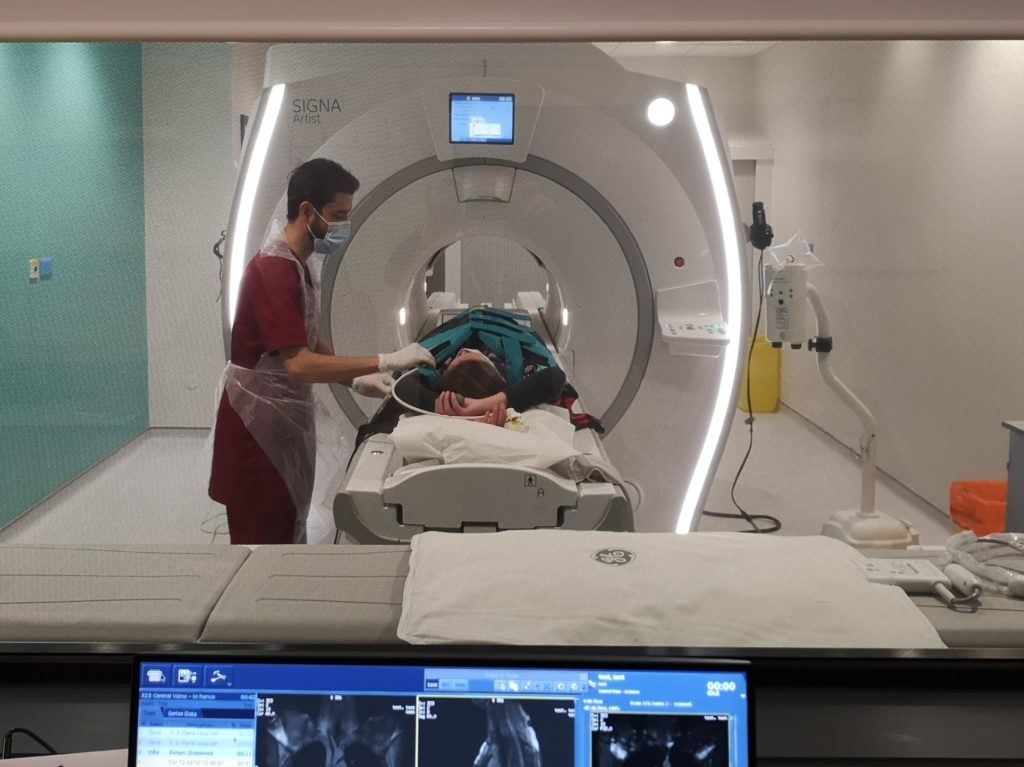Researchers have identified abnormalities in the lungs of long COVID patients who are experiencing breathlessness that cannot be detected with routine tests.

The EXPLAIN study, which involves teams in Oxford, Sheffield, Cardiff and Manchester, is using hyperpolarised xenon MRI scans to investigate possible lung damage in long COVID patients who have not been hospitalised with COVID-19 but who continue to experience breathlessness. The study, which received government funding in 2021, is supported by the NIHR Oxford Biomedical Research Centre (BRC).
The findings were posted on the medRxiv pre-print server.
A previous study had used the same cutting-edge method of imaging to establish that there was persistent lung abnormalities in patients who had been hospitalised with COVID-19 several months after they were discharged.
Hyperpolarised xenon MRI is a safe scanning test that requires the patient to lie in the MRI scanner and breathe in one litre of the inert gas xenon that has been hyperpolarised so that it can be seen using MRI. As xenon behaves in a very similar way to oxygen, radiologists can observe how the gas moves from the lungs into the blood stream.
The scan takes just a few minutes and, as it does not require radiation exposure, it can be repeated over time to see changes to the lungs.
While the full EXPLAIN study will recruit around 400 participants, this initial pilot had 36 people taking part, consisting of three groups:
- Patients diagnosed with long COVID, who have been seen in long COVID clinics and who have normal CT (computerized tomography) scans
- people who’ve been in hospital with COVID-19 and discharged more than three months previously, who have normal or nearly normal CT scans and who are not experiencing Long COVID
- An age- and gender-matched control group who do not have long COVID symptoms and who have not been hospitalised with COVID-19
These initial results show that there is “significantly impaired gas transfer” from the lungs to the bloodstream in these long COVID patients when other tests are normal.
EXPLAIN is one of 19 studies that have received nearly £40 million investment from the National Institute for Health Research (NIHR) to improve understanding of long COVID, from diagnosis and treatment through to rehabilitation and recovery.
The study’s Chief Investigator, Fergus Gleeson, Professor of Radiology at the University of Oxford and Consultant Radiologist at Oxford University Hospitals NHS Foundation Trust, said:

“We knew from our post-hospital COVID study that xenon could detect abnormalities when the CT scan and other lung function tests are normal. What we’ve found now is that, even though their CT scans are normal, the xenon MRI scans have detected similar abnormalities in patients with long COVID. These patients have never been in hospital and did not have an acute severe illness when they had their COVID-19 infection. Some of them have been experiencing their symptoms for a year after contracting COVID-19.
“There are now important questions to answer. Such as, how many patients with long COVID will have abnormal scans, the significance of the abnormality we’ve detected, the cause of the abnormality, and its longer-term consequences. Once we understand the mechanisms driving these symptoms, we will be better placed to develop more effective treatments.”
The method, development and clinical applications of hyperpolarised xenon MRI was pioneered by Professor Jim Wild and the Pulmonary, Lung and Respiratory Imaging Sheffield (POLARIS) research group at the University of Sheffield. The team performed the first clinical research studies in the UK and the world’s first clinical diagnostic scanning with this technology.
Professor Wild, Head of Imaging and NIHR Research Professor of Magnetic Resonance at the University of Sheffield, said: “Xenon MRI is uniquely placed to help understand why breathlessness persists in some patients post COVID. Xenon follows the pathway of oxygen when it is taken up by the lungs and can tell us where the abnormality lies between the airways, gas exchange membranes and capillaries in the lungs. This multi-centre study is very exciting, and I really look forward to it helping translate lung MRI methods that we have developed further towards clinical use in the UK.”
Dr Emily Fraser, Respiratory Consultant who leads the Oxford Post-COVID Assessment Clinic, said: “These are interesting results and may indicate that the changes observed within the lungs of some patients with long Covid contribute to breathlessness. However, these are early findings and further work to understand the clinical significance is key. Extending this study to larger numbers of patients and looking at control groups who have recovered from COVID should help us to answer this question and further our understanding of the mechanisms that drive long COVID.”
The full EXPLAIN study will recruit 200 long COVID patients with breathlessness, along with 50 patients who have had COVID-19 but now have no symptoms at all; 50 patients who have no breathlessness, but do have other long COVID symptoms, such as ‘brain fog’; and 50 people who have never had long COVID who will act as controls for comparison.
Professor Nick Lemoine, Chair of NIHR’s Long-COVID funding committee and Medical Director of the NIHR Clinical Research Network, said: “More than a million people in the UK continue to experience symptoms months after having COVID-19, with breathlessness one of the most commonly-reported symptoms. This early research is an important example of both the committed effort the UK research community is taking to understand this new phenomenon, and the world-leading expertise that community contains.”